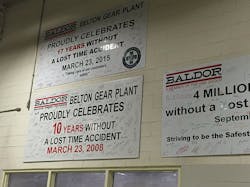SLC 2015: A Plant Tour of Baldor Electric Reveals Reasons for Outstanding Safety Record
A tour of the Baldor Electric in Belton, S.C., revealed a facility that cares about quality in terms of products, employee and contractor safety and stewardship of the facility. I always know I’m in a facility where people care when I don’t see spills on the floor, trash piled up near waste collection areas and paint that looks like it has not been touched up for years. If I didn’t know better, I would have thought Baldor’s facility was new, rather than nearly 25 years old.
Along with producing quality products, the gearbox manufacturer also is at the forefront of safe production. The Belton Plant has achieved 17 years without a lost-time accident. This equates to 4.45 million hours worked, and the facility is one of only three plants in the state that has been recognized for achieving more than 4 million hours without a lost-time injury.
Safety at the facility relies on the basics: providing employees and managers with the training and motivation to own safety.
“My job is to teach management how to manage safety,” said Safety Manager Paul Beaumont. “It can’t be done by one person. You have to involve managers.”
In addition, he said; “If an employee sees a safety issue, they own it.”
That wasn't always the case. In the fall of 2014, company management realized that employees and managers were taking unnecessary risks on behalf of maintaining high production levels. The safety statistics the company had captured for years showed management that it was doing the right things from a safety point of view, but a rash of serious accidents corporate-wide helped them understand that they were measuring the wrong things. None of the statistics focused on employees or their behaviors, and all of the serious incidents could be traced back to unsafe behaviors or conditions.
With input from employees at every facility, managers transformed the safety culture using a number of initiatives, such as reducing the span of control, implementing Safe Start at all locations and providing daily communication about safety best practices.
At one point, there were 120 employees for every manager corporate-wide. That is their "span of control." That ratio made it difficult for managers to manage anything very well, said Beaumont.
Now, the company now tries to maintain a ratio of one manager for 20 employees, which meant a commitment at the corporate level to hiring more managers. It also allows managers to know the employees who report to them, manage process such as safety and quality with more ease, keep on top of HR issues and provide better conflict management.
ABB’s influence has resulted in accident prevention heat maps, which provide safety goals that are color-coded according to percentage of completion. For 2016, ABB has determined that several aspects of safety across the country have grown stale and require renewed focus. These include ergonomics, hoist/crane safety, contractor safety and machine guarding.
The company created a new tool, called the Always/Never List, which is a simple way for employees to understand what the company is committed to. The list is:
We Always...
- Treat each other with respect and dignity.
- Watch out for ourselves and our coworkers.
- Wear proper attire and personal protective equipment.
- Give full attention to our work.
- Report safety incidents immediately (accidents, unsafe acts, near misses.)
- Follow electrical safe work practices.
- Inspect our equipment at start up.
- Lock out and tag out (LOTO) our equipment as required.
- Follow good housekeeping practices.
- Look before we move and make eye contact with lift truck drivers.
We Never...
- Do something unsafe in order to satisfy a customer, our boss or anyone else.
- Place ourselves in harm's way or in the line of fire.
- Compromise safety for any reason.
- Walk away from an unsafe condition or behavior without taking action.
- Do anything we have not been trained to do or anything we have been trained not to do.
- Defeat a safety guard or device.
- Place any body part under a supervised load.
- Trust our safety to someone else.
- Take short cuts.
- Perform non-standard work without stoppng and taking 5.
One thing is certain; Beaumont and Baldor’s Belton employees are proud of what they’ve accomplished. Large signs as you enter the main part of the facility recognize the years worked without a lost-time accident. The banners for each year are signed by employees, to acknowledge the role they played in maintaining a safe and healthy facility.
“My goal is to work myself out of a job in 10 years,” said Beaumont, “to have managers and employees have complete ownership of safety.”
About the Author

Sandy Smith
Sandy Smith is the former content director of EHS Today, and is currently the EHSQ content & community lead at Intelex Technologies Inc. She has written about occupational safety and health and environmental issues since 1990.
